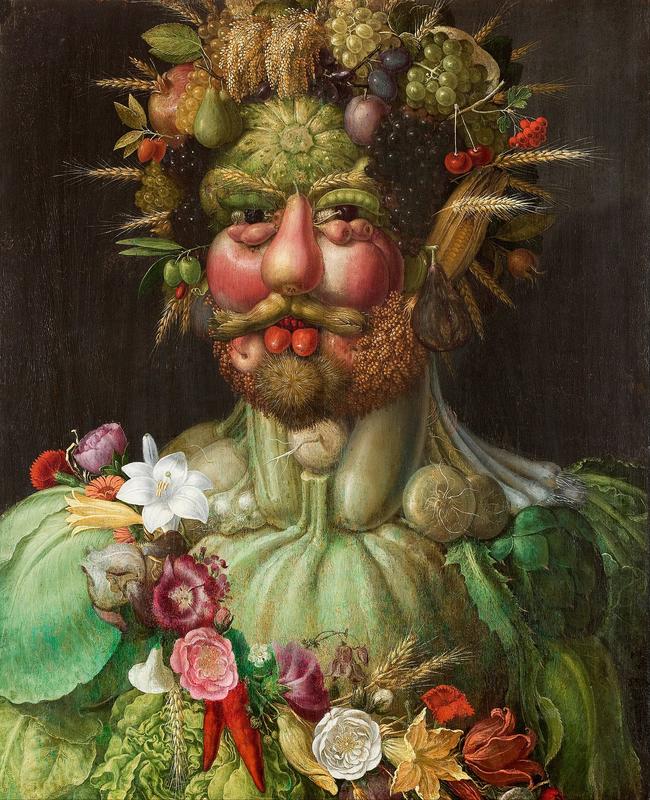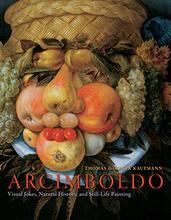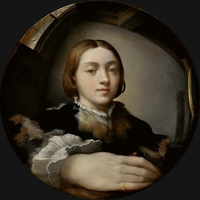More about Vertumnus
- All
- Info
- Shop

Sr. Contributor
It’s hard to believe, but this portrait by Giuseppe Arcimboldo is not a flex for vegans everywhere.
This delicious little salad buffet of a man is an example of Arcimboldo’s signature, yet supremely weird, style. You see, similar to the other Renaissance men who came before him, Arcimboldo was fascinated with the natural sciences. Like Leonardo, Arcimboldo had a keen eye for biology and worked his interests into his artworks. Like Albrecht Dürer, Arcimboldo appreciated the elements of nature, which clearly impacted how and what he painted. Luckily, this famously wacky artist had patrons who believed in him enough to explore his wild side and create the most experimental portraits of his time.
Although he hailed from Italy, Arcimboldo’s fellow countrymen didn’t exactly understand where he was going with his unique portraits. Arcimboldo finally decided to leave his native Milan when a particularly stiff archbishop took over. Arcimboldo eventually landed a sweet gig as the court painter for three different Holy Roman Emperors from the Hapsburg family in Vienna and Prague. Unlike the fraught relationship between court painter and royal family that is evident in Goya’s Charles IV of Spain and His Family, Arcimboldo and the Hapsburgs were just peachy. Arcimboldo’s strange style fit well with the Hapsburgs’ sense of humor and desire to support intellectual innovation.
Although Arcimboldo joined the court to paint for Emperor Rudolf II’s father Maximilian II in the early 1560s, this portrait is a testament to how well the artist and Rudolf also got along. Arcimboldo portrayed Rudolf II as Vertumnus, the Roman God of the Seasons, using fruits and vegetables to construct the emperor’s likeness. Armed with the biological knowledge and observant eye that emerged during the Renaissance, Arcimboldo ensured that he accurately rendered each piece of organic matter. Nevertheless, depicting the Holy Roman Emperor as a pile of fruit known as Vertumnus is certainly a curious choice, and the reason for that choice lies not just in the Renaissance love of nature, riddles, and whimsy. As a god of all the seasons, Vertumnus suggests permanence, and thus the permanence of Rudolf's reign. Furthermore, by being portrayed as this god of growth, plants, and nature, Rudolf's power seems to extend not just to his realm and subjects, but over nature itself, with the bounty of fruits and flowers suggesting that under Rudolf's rule, the empire would flourish.
You may be wondering how such a prized painting of a revered Holy Roman Emperor wound up in its current location, a Swedish castle. In 1648, at the end of the Thirty Years’ War, the victorious Swedes looted Emperor Rudolf’s world-famous Art Chamber from his home in Prague, anxious to bring back the spoils of war to their queen, Kristina. After the painting was looted by the Swedish army, its whereabouts were unknown until the 1850s. It's possible that Count Carl Gustaf Wrangel managed to snag Vertumnus and bring it back to Skokloster, the impressive castle that he built in Sweden. Now pass the hummus. I’m getting hungry.
Sources
- Greek Mythology.com. “Vertumnus.” 9 March 2016. https://www.greekmythology.com/Other_Gods/Minor_Gods/Vertumnus/vertumnu…. Accessed 13 April 2022.
- National Gallery of Art. “Arcimboldo’s Famous Paintings of Delightfully Bizarre Heads are on View Together for the First Time in the United States at the National Gallery of Art.” Communications Office. Exhibitions. 9 September 2010. https://www.nga.gov/press/exh/3053.html. Accessed 13 April 2022.
- Selvin, Claire. “How Giuseppe Arcimboldo Reimagined Portraiture in 16th-Century Europe.” Artists. ARTNews. 1 October 2020. https://www.artnews.com/feature/giuseppe-arcimboldo-who-is-he-famous-wo…. Accessed 12 April 2022.
- Skoklosters slott. https://skoklostersslott.se/en/visit/castle. Accessed 29 March 2022.
- Tucker, Abigail. “Arcimboldo’s Feast for the Eyes.” Arts & Culture. Smithsonian Magazine. January 2011. https://www.smithsonianmag.com/arts-culture/arcimboldos-feast-for-the-e…. Accessed 13 April 2022.
Featured Content
Here is what Wikipedia says about Vertumnus (Arcimboldo)
Vertumnus is an oil painting produced by the Italian painter Giuseppe Arcimboldo in 1591 that consists of multiple fruits, vegetables and flowers that come together to create a portrait of Holy Roman Emperor Rudolf II. Although Arcimboldo's colleagues commented that Vertumnus was scherzo, or humorous, there were intentional political meanings behind the piece, particularly regarding the choice of fruits, vegetables, and flowers. Arcimboldo's choice to include these items was also an intentional reference to the Roman god, Vertumnus.
Vertumnus was presented to Rudolf II after its completion. It was looted by the Swedish army after the Thirty Years' War. Although art historians lost track of Vertumnus after this shift, it reappeared in 1845 in Sweden in Skokloster Castle, where it remains.
Check out the full Wikipedia article about Vertumnus (Arcimboldo)
















